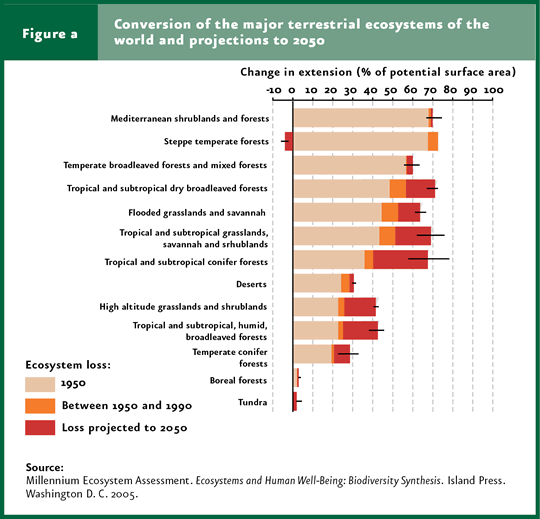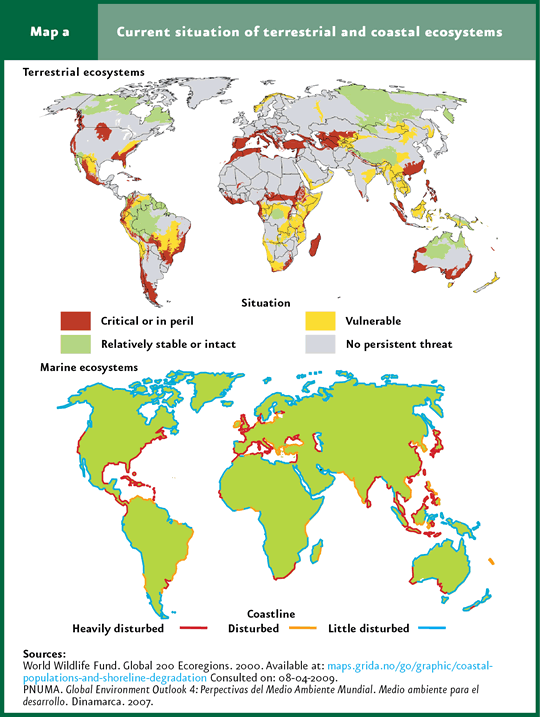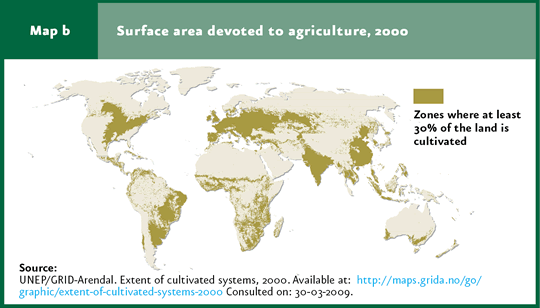According to the Millennium Ecosystem Assessment (MEA, 2005b) man has transformed ecosystems (both terrestrial, fresh water and marine) more rapidly and intensively over the past 50 years than in any other equivalent period of history, affecting both the functioning and ability to supply environmental services currently and in the future.
If the area likely covered by the fourteen major terrestrial ecosystems acknowledged by MEA is considered, in six of them at least 50% of the original area has been transformed towards other land uses by 1990, mostly for farming practices (Figure a). Particularly serious is the case of the transformation of savannas and temperate forests, the overall surface of which was reduced in nearly 75% of the original area by 1990, as well as that of the Mediterranean biomes and the mixed and deciduous temperate forests. By contrast, the biomes that prosper in very cold areas have been the best preserved ones, likely as a result of their poor suitability for agriculture, as in the case of the cold forests and the tundra.

In the case of the world forests - both temperate and tropical -, the original area has undergone a nearly 50% reduction over the past three centuries, having virtually disappeared in 25 countries; additionally, its extension has been reduced in more than 90% in other 29 countries. Despite of efforts by many countries to preserve this forest cover, the irrational use of forests is reflected in a net global loss, which according to FAO (2005) has reached 9.4 million hectares per year.
Inland aquatic ecosystems are the ones displaying the most serious deterioration to date: for instance, although no data are available to support this statement, it is estimated that 50% of fresh water wetlands over the world (excluding rivers, lakes and other water reservoirs) has been lost since 1900, mostly due to water overexploitation, infrastructure development, land use changes, fishing overexploitation and eutrophication. Furthermore, It is estimated that 60% of the main rivers around the world have been fragmented as a result of damps and deviations, hence significantly reducing freshwater biodiversity, derived from habitat flooding and the isolation and disruption of migration routes used by animal populations (PNUMA, 2007).
The extent to which the world ecosystems are threatened is shown in Map a (top). The most threatened ecosystems include those in countries as rich and diverse as Madagascar, Indonesia, as well as the Brazilian Amazonia and the Mediterranean zone, whereas most ecosystems in arid and semiarid zones in all continents show no evidence of a persisting threat. In the case of coastal ecosystems, it can be seen that coastal areas with the highest degree of development and population size display the most altered conditions - for instance, the Mediterranean area, the United States’ Eastern Coast, the Caribbean and Japanese islands -, while the less developed Boreal coasts show far less significant alterations (Map a, bottom).

The growth of the cultivated area is the major evidence of the loss of ecosystems throughout the world: it has been estimated that more land was devoted to agriculture between 1950 and 1980 - previously covered by forests and natural grasslands - than the area dedicated to agriculture throughout the whole XVIII century and first half of the XIX century. Today, nearly one quarter (24%) of the Earth’s land is cultivated (Map b), and even when having contributed to meet the feeding demand, it has also brought about significant environmental and economic costs.

The future of many ecosystems looks discouraging. According to MEA projections (2005), some biomes will probably have lost a highly significant proportion of their potential area by the year 2050, mostly in the case of conifer, tropical and subtropical forests (the loss of which may reach up to 80% of the potential area by that date), dry tropical and subtropical forests (about 75%) and savanna, shrublands, tropical and subtropical grasslands (80%), among others (Figure a). For their part, mountain grasslands and shrublands, as well as tropical and subtropical rainforests may loose nearly the same area already lost until 1950 between 1990 and 2050, according to projections, which may lead to a loss of nearly 50% of their potential area.
References:
MEA. Ecosystems and Human Well-being: Biodiversity Synthesis. World Resources Institute. Washington, D.C. 2005.
PNUMA. Global Environment Outlook 4: Perspectivas del Medio Ambiente Mundial. Medio ambiente para el desarrollo. Denmark. 2007.
|